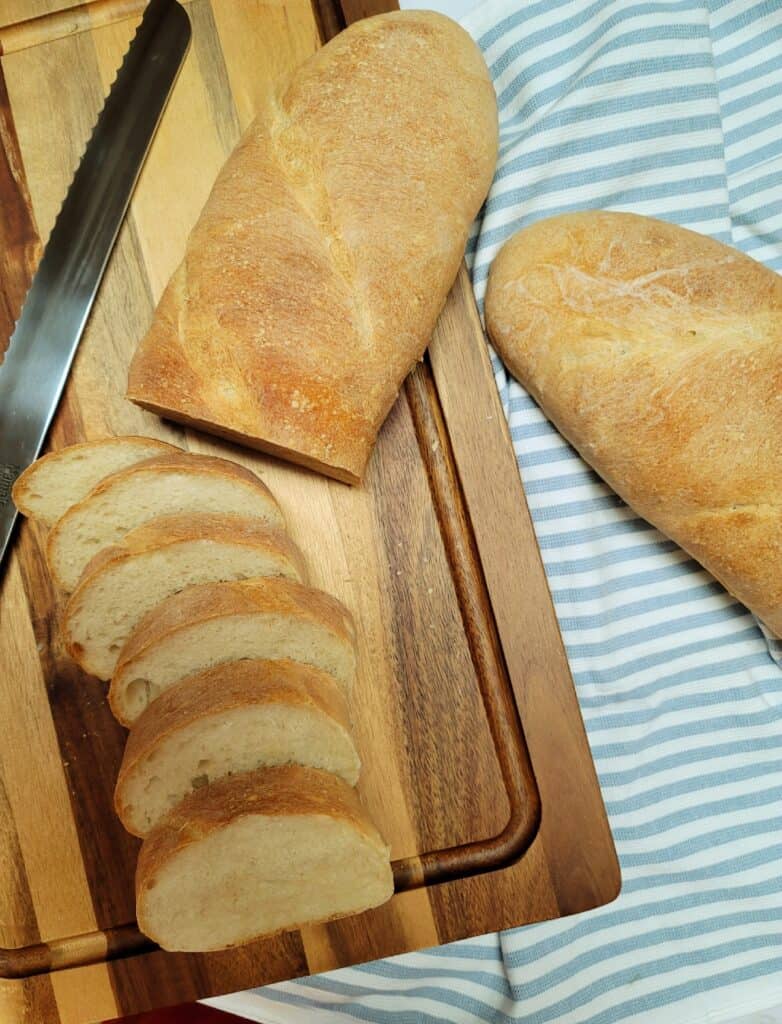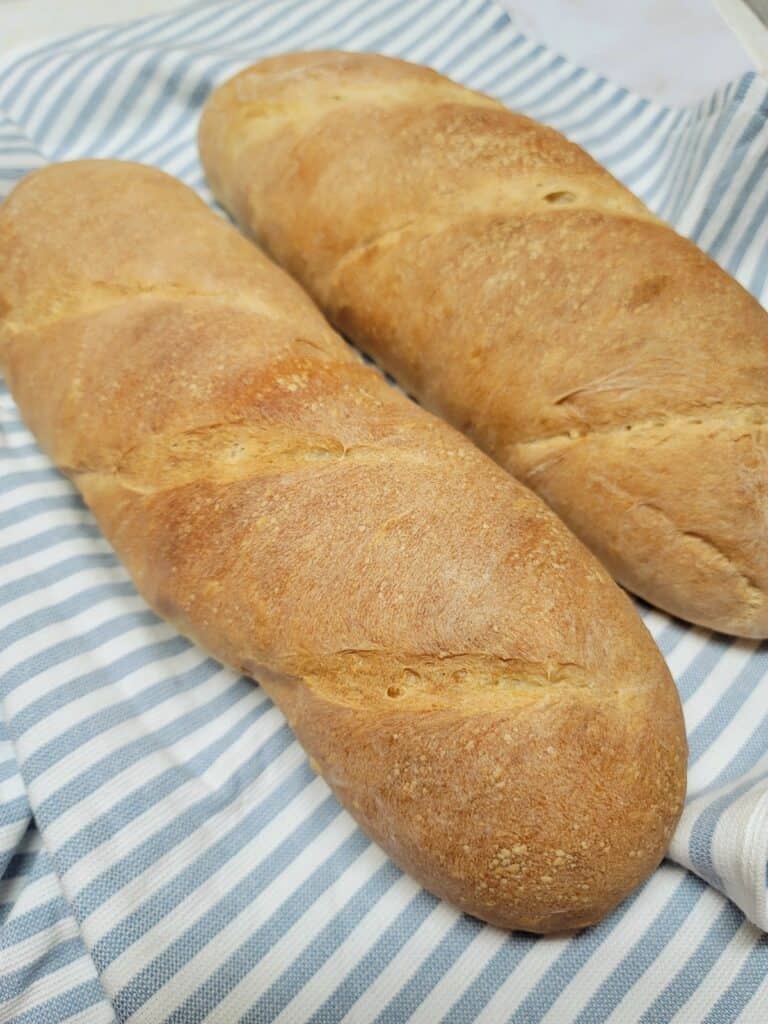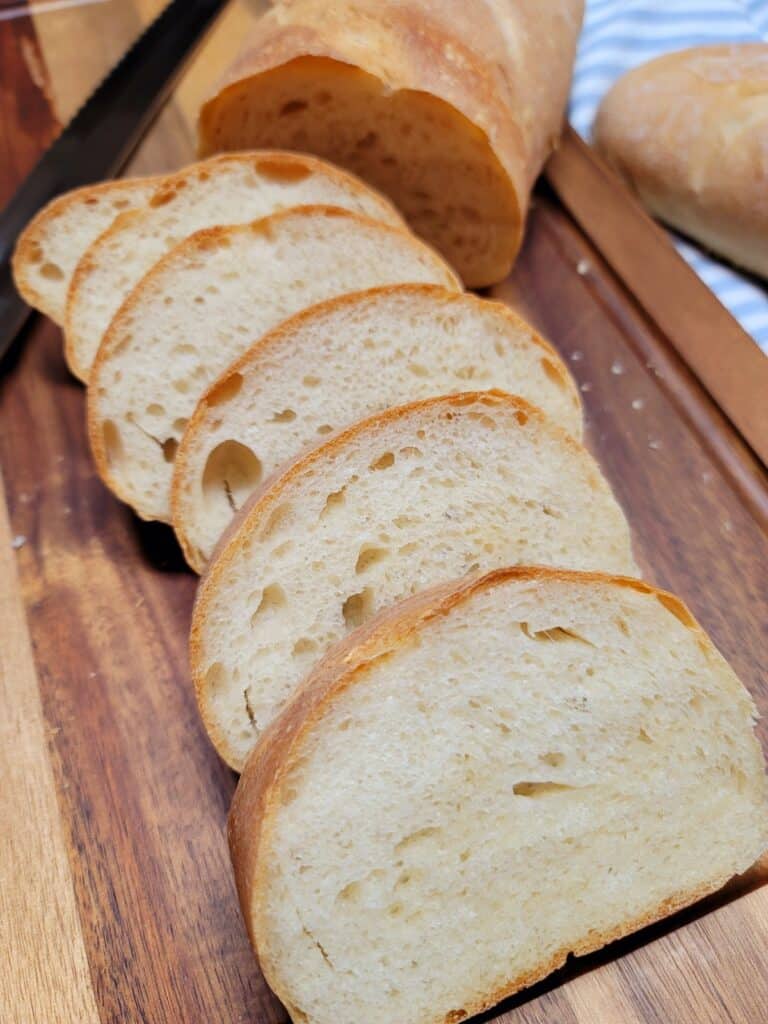French Bread

Easy French Bread that turns out delicious every time. Golden and crispy on the outside with a soft and chewy inside. You will never buy French Bread again after you make this easy recipe.

I absolutely love making fresh bread. There is something so satisfying about pulling a fresh loaf of bread out of the oven, knowing you made it. Fresh bread that isn't full of softeners and preservatives, just a few simple ingredients. Homemade french bread has a much better texture than the grocery stores bread. After making this recipe for yourself, I am sure you will agree. I have not purchased french bread in too many years to count. I always have a loaf of this french bread in my freezer for whenever I need it. Since this recipe yields two loaves, it is super easy to always have one in the freezer.
I know bread making can be intimidating. Especially if you are new to it. I will try to provide as many tips as I can to help you learn how to make perfect bread every time. The more you make it, the better you will be at eyeballing the dough and knowing when each step has been completed. The best tip I can give you, is the one that has helped me the most. Think of the recipe as a guideline. The amount of flour needed may be more or less than what the recipe calls for. Don't assume the amount in the recipe is what you will need. Being able to know when to stop adding flour is a skill you will learn the more you make bread.
Tips for Making French Bread
- Less is more. When it comes to flour, less is more. Adding too much flour will cause your bread to be dense. You should never add enough flour for the dough to become dry. Flour can hold moisture, and the air holds moisture. These two factors alone effect how much flour you will need to use in your dough. When adding the flour always add a little at a time and watch how the dough reacts after a little kneading. If the dough starts to fall from the dough hook and isn't coming together, it is too wet. Add more flour. Knead a little more and check. When touched, the dough should feel soft and tacky, not sticky and wet.

- Oil. Adding olive oil to the dough helps develop a softer crumb. I have been using oil in this recipe for years and have loved how soft the crumb texture is.
- Fully knead the dough. Don't rush the kneading process. Make sure to fully knead the dough for the best results. Kneading develops the gluten which gives bread its shape and texture. You will know the bread is fully developed when it forms a ball and is very stretchy. The dough should not tear easily when stretched.
- Fully proof the dough. Proofing is equally as important as kneading the dough. An underproved dough will not rise as much when baked and you will be left with a dense loaf of bread. When proofing the dough, the first time (bulk fermentation), allow it to double in size. The warmer the kitchen, the faster this will happen. If it is cold in your kitchen, this will take longer. During the second rise, the dough will double in size again. This rise is important for adding volume to your dough. To check if the dough is fully proofed, gently press the dough and watch how it reacts. If the there is a dimple left in the dough, allow it to continue proofing. If the dough springs back, it is ready to bake.
- Shaping. Properly shaping the loaves is important for structure.
- Scoring the bread. Scoring the bread allows the gases to release where you want them to. If the bread isn't scored properly the gases will creates their own escape route. Which isn't ideal.
- Allow to cool completely. This is certainly the hardest part of baking any bread, allowing it to cool completely before slicing into it. This is VERY important. By letting it cool you are allowing the bread to finish cooking on the inside and releasing moisture. If sliced into when the bread is too hot, the inside will have a doughier texture. You spent all that time and effort making it, let it finish before diving in.
Check Out These Bread Recipes
How to Make French Bread
Using a mixer is very helpful when making bread dough. Although kneading can be done by hand, using a mixer with a dough hook moves the process along faster.
1. In the bowl of a mixer combine the yeast and warm water. Once the yeast has started to dissolve add in the sugar, salt and olive oil. Mix until combined.
2. Add in all of the bread four and half of the all-purpose flour. Using the dough hook, begin kneading on low. Add in more flour, 1/4 -1/2 cup at a time, making sure all of the flour is mixed in a has been kneaded for 1 minute before adding in more flour. Once the dough has enough flour, knead for 8-10 minutes or until the dough is fully developed. The dough should be shiny and elastic. Take a piece of the dough and stretch it out as far as you can, if it tears easily, knead longer. If it is really stretchy it is done.
3. Lightly cover the dough in olive oil, cover with a damp cloth and let rise until doubles. This may take 2 hours or longer depending on the temperature of your kitchen.
4. Once the dough had doubled, turn it out onto a lightly floured or oiled surface. Divide the dough into two equal pieces. Working with 1 piece of dough, flatten out into a rectangle. Gently stretch and fold the top part of the dough down to the bottom of the dough, leaving 1" of space. Using the heel of your hand seal the edge.

5. Using the heel of your hand press a well (horizontally) down the middle of the dough. Fold the top over to the bottom again, using the same technique to seal the edges.
6. Then gently start rolling the dough, with your hands in the middle of the loaf, using the palms of your hands to roll the dough out into a long loaf. Place the loaf, seam side down, on a parchment lined baking sheet. Make sure it is large enough for both loaves of bread to rise. Continue with the second loaf.
7. Cover with a towel and let proof until doubled.
8. When the dough has almost doubled, place a small pan, such as a round cake pan, in the bottom of the oven. This is for water that will produce steam. The steam helps create a good crust. Preheat the oven to 450° F.
9. Once the loaves have doubled in size, score with a bread lame, place into the oven. Carefully pour 1 cup of water into the pan, close the oven and bake for 20-25 minutes.
10. Check the bread by carefully picking it up and tapping the bottom of the loaf, if it sounds hollow it is done.
11. Allow to fully cool before slicing. Enjoy!
For an even crustier loaf of French Bread, fill a spray bottle with water and spray the bread every 2 minutes for the first 8 minutes of baking.
Easy French Bread that turns out delicious every time. Golden and crispy on the outside with a soft and chewy inside. You will never buy french bread again after you make this easy recipe.
- 2 1/4 tsp dry active yeast
- 1 2/3 cup warm water
- 1 Teaspoon sugar
- 1 1/2 tsp salt
- 1 Teaspoon olive oil
- 2 cup bread flour
- 2-3 cup all-purpose flour
In the bowl of a mixer combine the yeast and warm water. Once the yeast has started to dissolve add in the sugar, salt and olive oil. Mix until combined.
Add in all of the bread four and half of the all-purpose flour. Using the dough hook, begin kneading on low. Add in more flour, 1/4 -1/2 cup at a time, making sure all of the flour is mixed in a has been kneaded for 1 minute before adding in more flour. Once the dough has enough flour, knead for 8-10 minutes or until the dough is fully developed. The dough should be shiny and elastic. Take a piece of the dough and stretch it out as far as you can, if it tears easily, knead longer. If it is really stretchy it is done.
Lightly cover the dough in olive oil, cover with a damp cloth and let rise until doubles. This may take 2 hours or longer depending on the temperature of your kitchen.
Once the dough had doubled, turn it out onto a lightly floured or oiled surface. Divide the dough into two equal pieces. Working with 1 piece of dough, flatten out into a rectangle. Gently stretch and fold the top part of the dough down to the bottom of the dough, leaving 1" of space. Using the heel of your hand seal the edge.
Using the heel of your hand press a well (horizontally) down the middle of the dough. Fold the top over to the bottom again, using the same technique to seal the edges.
Then gently start rolling the dough, with your hands in the middle of the loaf, using the palms of your hands to roll the dough out into a long loaf. Place the loaf, seam side down, on a parchment lined baking sheet. Make sure it is large enough for both loaves of bread to rise. Continue with the second loaf.
Cover with a towel and let proof until doubled.
When the dough has almost doubled, place a small pan, such as a round cake pan, in the bottom of the oven. This is for water that will produce steam. The steam helps create a good crust. Preheat the oven to 450° F.
Once the loaves have doubled in size, score with a bread lame, place into the oven. Carefully pour 1 cup of water into the pan, close the oven and bake for 20-25 minutes.
Check the bread by carefully picking it up and tapping the bottom of the loaf, if it sounds hollow it is done.
-
Allow to fully cool before slicing. Enjoy!
This recipe makes 2 loaves of French Bread.
The above post has helpful tips for making French Bread.
Thank you for stopping by!